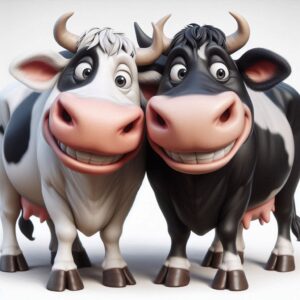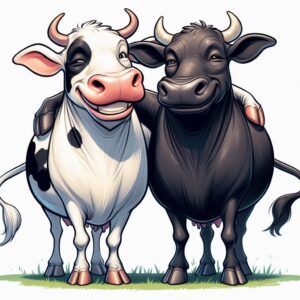動物に肌の色は関係ないとは?
この風刺画について
この風刺画は、「動物に肌の色は関係ない(Skin color doesn’t matter to animals)」というメッセージをテーマに制作しました。
風刺画には3組の異なる動物たちが描かれています。それぞれのペアは色が異なるにもかかわらず、仲良く肩を寄せ合っています。
牛、犬、そしてクマという種類の異なる動物を描くことで、種を超えた共通性、つまり「色ではなく心でつながる」という普遍的な価値観を表現しました。
左の牛たちは、白黒のホルスタインと黒牛のペアです。中央の犬たちは黒い子犬と白い子犬、右のクマはホッキョクグマとヒグマのような対照的な色合いです。
これらはすべて、「外見が違っても、心が通じ合えば関係ない」ということを端的に示しています。
この風刺画は、可愛らしさを前面に出しつつも、現代社会が抱える人種差別や偏見の問題に静かに、しかし確実に訴えかける作品です。
動物たちは、私たち人間のように肌の色や見た目で他者を差別したりはしません。
ただ「そこにいる仲間」として、対等に接しています。その純粋さを見習うべきだというメッセージを、この一枚に込めました。
「可愛い」で終わらず、見た人の心に問いを残すこと。それがこの風刺画の存在意義です。
風刺画のポイント
この作品を描くにあたって、最も意識したのは「シンプルであることの強さ」です。
風刺というと、時に過激で皮肉な表現になりがちですが、私はこの絵であえてその逆を選びました。
あたたかさ、可愛らしさ、安心感。
それらを前面に出しながらも、「なぜ人間だけが肌の色で争うのか?」という、社会への疑問を静かに投げかける構造にしました。
まず、登場する動物の選定にも意味があります。
牛は農耕社会の象徴であり、人類にとって最も身近な動物の一つです。
犬は家庭の中で愛される存在として、友情や忠誠を象徴します。
そしてクマは野生の象徴であり、力強さと優しさの両面を持つ存在です。
この3種類の動物に共通するのは、色の違いにとらわれず共存しているという点です。
また、全ての動物が「肩を組む」ポーズをとっている点も重要です。
これは、単なる共存ではなく「連帯」や「友情」を意味します。
どのキャラクターも、笑顔で相手に寄り添っており、それが無言の説得力を生み出しています。
視線や表情は意図的にポジティブに描くことで、子供から大人まで幅広い層に受け入れられるビジュアルに仕上げました。
色彩についても、単なるコントラストではなく、調和を意識して構成しています。
背景はあえて白くし、動物たちの存在感を強調しました。
これは、私たち人間社会においても「背景にある偏見や歴史」ではなく、「今ここにいる存在そのもの」に目を向けてほしいという願いを込めています。
最後に、タイトルと英訳の配置にもこだわりました。
日本語と英語を並列させることで、国境を越えたメッセージ性を持たせています。
これはSNSでの拡散や国際的な共感を狙ったデザインでもあります。英語圏と日本語圏のどちらの人々にも伝わるよう、字体や色調も慎重に選びました。
この風刺画は、「差別」や「分断」に対して、怒りではなく優しさで抗う一枚です。
動物たちが教えてくれる「違いを受け入れる力」を、ぜひ人間も学んでほしいと願っています。
AIが描いた「動物に肌の色は関係ない」
 |
 |
 |
 |
 |
 |
 |

コメント